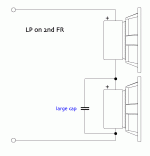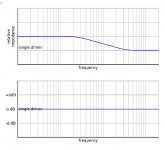I think there might be a little confusion here. The purpose of a X.5 way is to reduce the mid and high out put from one of the two drivers.
A normal X.5 way is with the drivers in parallel with one of them having a coil in series and perhaps a shunting cap.
In a series crossover if you run a coil on one side to ensure the high end cut off of one of the drivers you have to put a resistor on the other side or you'll have a short. If you add the cap instead of a resistor, you've just made a normal series XO that divides between a woofer and tweeter and there'd be no point in using two of the same driver. You'd be losing the low end of that driver which effectively defeats the purpose.
A normal X.5 way is with the drivers in parallel with one of them having a coil in series and perhaps a shunting cap.
In a series crossover if you run a coil on one side to ensure the high end cut off of one of the drivers you have to put a resistor on the other side or you'll have a short. If you add the cap instead of a resistor, you've just made a normal series XO that divides between a woofer and tweeter and there'd be no point in using two of the same driver. You'd be losing the low end of that driver which effectively defeats the purpose.
Cap size depends on driver impedance & baffle width. A fellow with Lotus^2 used 68 uF
dave
So something like this
Obbligato Film Oil Capacitors homepage
They are huge but in my case its ok
I read that it can help with discharge if you put a low value cap in front of a large value cap, dunno how true this is
Last edited:
I can't see why you want the cap in there. The idea of the 1.5 is to increase the bass.
The cap shunts hi-frequencies past the associated driver. To act as BSC one needs to use a current amp. With a voltage amp the increase in efficiency is countered by a factor of 2 decrease of power, so there is no lift.
dave
Attachments
So something like this
Obbligato Film Oil Capacitors homepage
I'd be using the poly caps. A "cheap" Solen with a higher quality bypass cap would be suggested.
I read that it can help with discharge if you put a low value cap in front of a large value cap, dunno how true this is
Since you are passing AC there is not much charge build-up.
dave
Dave, is a bypass cap a small value cap placed after the first? not sure I've ever read about this before.
Hi Bill. Dave is out getting ready for his big shin dig in August. If you look at what he posted in #43, you can see there is only one cap.
I had gone off on another tangent earlier but I'm safely back on earth now.
I had gone off on another tangent earlier but I'm safely back on earth now.
Dave is out getting ready for his big shin dig in August.
Right Cal, but we just keep on asking! 😱
Will try to remember. 🙂
Dave, is a bypass cap a small value cap placed after the first?
In parallel.
dave
I'd be using the poly caps. A "cheap" Solen with a higher quality bypass cap would be suggested.
dave
Just realised that using air core would mean a massive coil! I havent the space in the base of the speaker and it wd add a third to the weight of the cab.
Torn between the Erse Super Q magnetic core and using caps in the way you suggested. The coil wd be a simple solution but still heavy, the caps wd keep the weight down ie Pulse X with a v low value Mundorf silver oil
If you wire 2 drivers in series, you use a shunt cap on one driver to cut its HF. One requires a current amp to get the power increase needed to get typical baffle step compensation. (ie with a (true) voltage amp you only achieve double the cone area at low frequencies, no gain in sensitivity)
dave
Hi dave, I'm sorry this is an old post. I'm having trouble understanding why there's no baffle step compensation if one driver really does have the highs rolled off, in a series connection with a cap on one driver. Wouldn't there be less highs then overall? I wouldn't bring it up, but this would work out well in my project if I could get the BSC this way. Thank you!
Have a look here — i am working on a revision of this document with this, the existing 4 driver, with added information as developed in the 3-driver wiring.
http://www.planet10-hifi.com/downloads/Dual-Driver-Wiring.pdf
In short, with a voltage amp, one gains 3dB due to the doubling of the drivers, but -3dB in power being delivered so the net is zero.
So at higher frequncies you are delivering N Watts, at LF you only have N/2 Watts.
dave
http://www.planet10-hifi.com/downloads/Dual-Driver-Wiring.pdf
In short, with a voltage amp, one gains 3dB due to the doubling of the drivers, but -3dB in power being delivered so the net is zero.
So at higher frequncies you are delivering N Watts, at LF you only have N/2 Watts.
dave
Thank you! So series connection does have BSC with a cap across one driver, because of the rolloff of the highs of one driver, and I just didn't understand it. This is good news!
No. Series wiring does not do the same thing as using a 2nd driver as BSC. That requires a rise in output at low frequencies of 2-6dB.
It just doubles the cone area, greatly increasing LF output, but without the hassle of BSC (very often causing as many issue sas it fixes).
dave
It just doubles the cone area, greatly increasing LF output, but without the hassle of BSC (very often causing as many issue sas it fixes).
dave
I can't understand why there are not less highs though if the highs of one driver are rolled off. I understand there will be no +3db like with parallel, but if there's a high cut of one driver, why is there the same amount of highs..?
I don't get it.. Why does the value of the cap matter, if there is no change in the frequency response?
I don't get it. Why does the value of the cap matter, if there is no change in the frequency response?
The size of the cap in this config is not overly critical, its choice needs to be made to suit the application and needs to be large enuff that the LF driver does not come in until the driver centre-centre is less than a quarter wavelength.
Other consideartions could be box width and cap cost (you dont want a cheap bi-polar).
A zobel is a C in series with an R to flatten th eimpedance at high frequencies (for XO development, or sometimes to make the amp happier).
dave
- Home
- Loudspeakers
- Full Range
- 1.5 way crossover question

 Dumb Cal posts removed.
Dumb Cal posts removed.